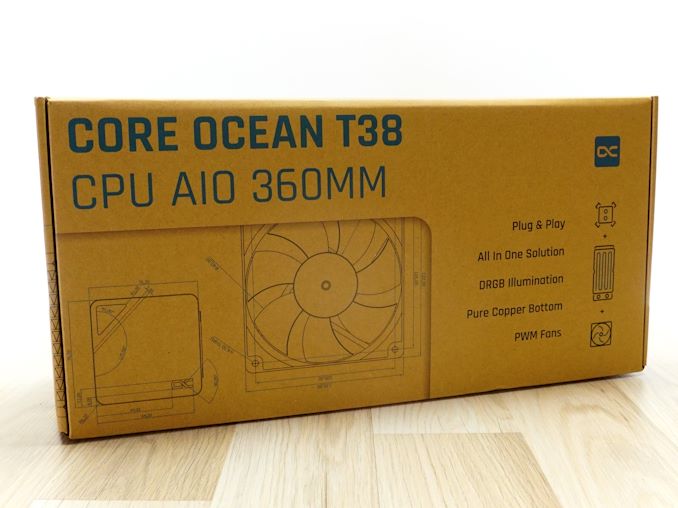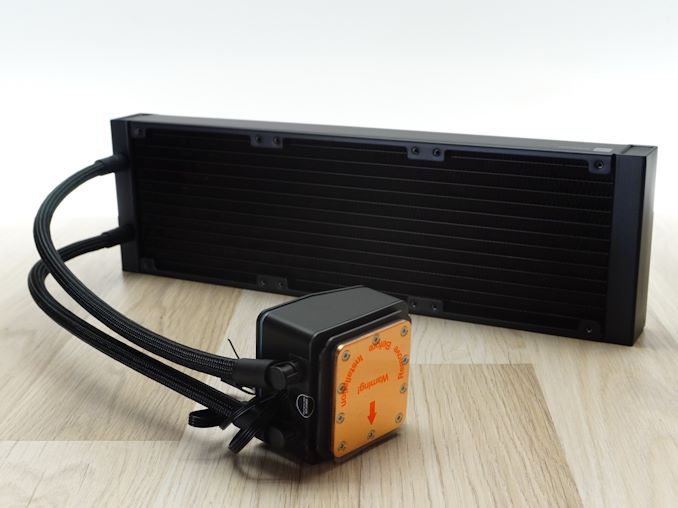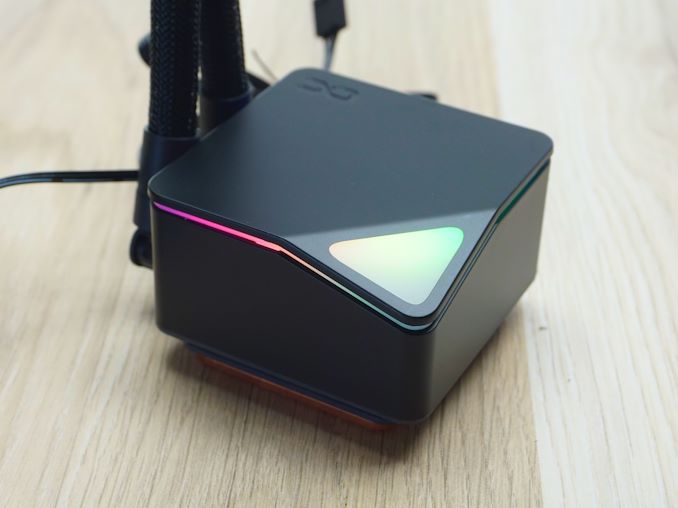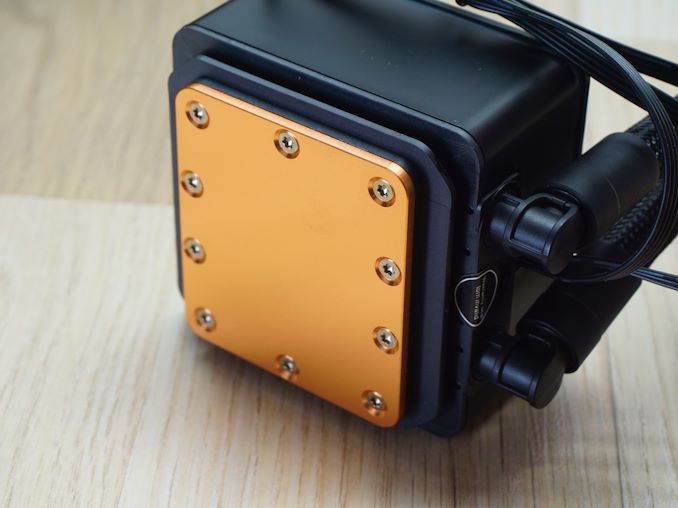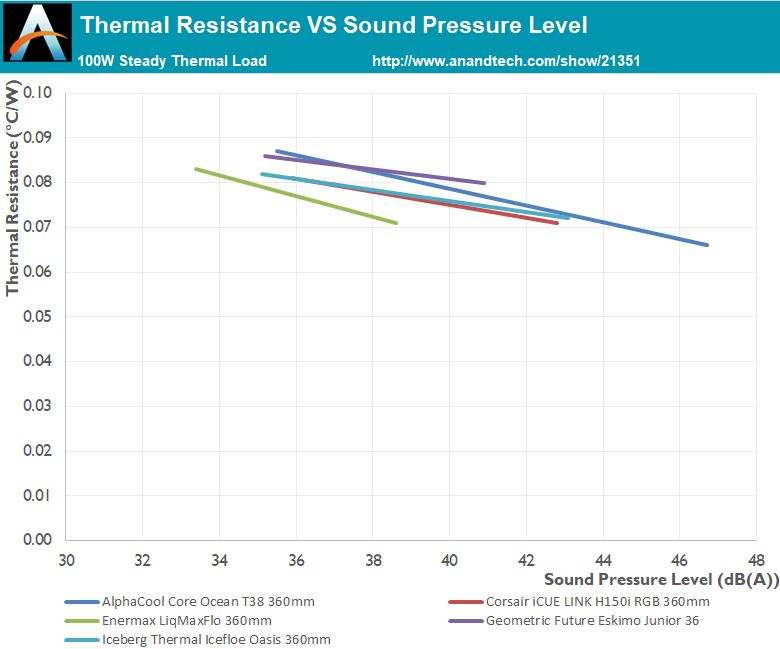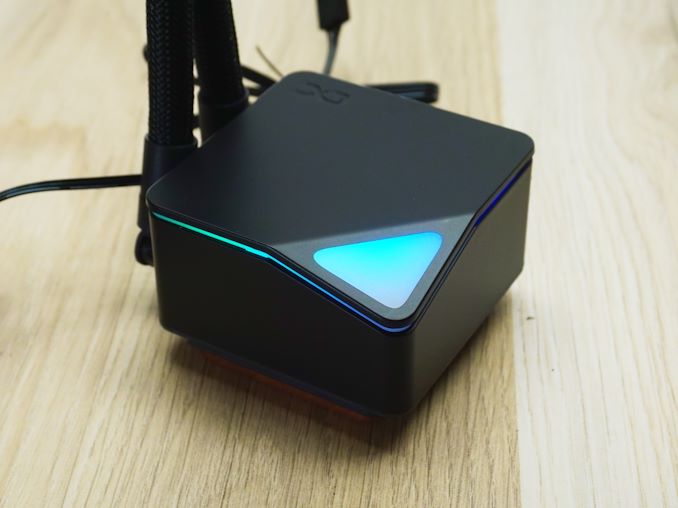While the all-in-one CPU cooler industry is dominated, at least in mindshare, by flagship coolers from the industry’s biggest brands, the market segment overall has grown over the years to cover a much larger gamut of users. From flagship coolers to sub-$100 specials, effective AIO coolers have become available and affordable for most mid-range and higher builds. Thanks in part to some intensive competition in this space, we’ve seen several vendors bring down even 360mm coolers to the sub-$100 market in an effort to get in an edge over their competitors, and a sale in the process.
Looking at an opportunity to grow their own customer base, even the normally premium-focused AlphaCool has opted to get into this action with their Core Ocean lineup of coolers. And today, we’re taking a closer look at the Core Ocean T38 360mm, AlphaCool’s latest entry-level AIO cooler.
At a high level, the Core Ocean T38 has been designed to balance performance with manufacturing costs, allowing the company to put together an effective cooler that can still be priced low enough to reach budget-conscious consumers. Sticking with an aluminum radiator and keeping the frills such as RGB lighting to a minimum, the T38 is primarily aimed at system builders who require straightforward, effective cooling solutions – and without the complexity of AlphaCool’s renowned open-loop custom liquid cooling kits. As we’ll see, nothing comes for free, but AlphaCool has been able to put together a rather effective CPU cooler for $100 that’s hard to ignore.
| AlphaCool Core Ocean T38 360mm AIO CPU Cooler Specifications |
|||
| Type | All-in-One Liquid Cooler | ||
| Dimensions | 397 x 120 x 63 mm (radiator with fan) | ||
| Fans | 3 x 120 mm Hydraulic Bearing Fans 2500 RPM (max) |
||
| RGB | Yes, Pump (RGB) | ||
| Supported Sockets | Intel: LGA1700 / LGA1851
AMD: AM5 / AM4 |
||
| Warranty | 3 Years | ||
| Price | $100 | ||
AlphaCool packages the Core Ocean T38 AIO CPU cooler in a simple and functional cardboard box, the dimensions of which are indicative of the cooler’s size. The front of the box features basic dimensional schematics, delivering a professional aesthetic theme. Inside, the cooler is securely housed within custom cardboard inserts, carefully engineered to protect the cooler during shipping and handling, ensuring it reaches the customer in excellent condition.
As expected from an entry-level product, the bundle accompanying the Core Ocean T38 AIO is limited to just the parts that are absolutely necessary for the installation of the cooler. Aside from the mounting hardware, there is a syringe of premium thermal compound and a 3-to-1 power connector for the radiator fans.
At first glance, the AlphaCool Core Ocean T38 AIO CPU cooler follows the same general design as most AIO coolers available today. It adheres to the conventional AIO structure, which includes a single radiator, two hoses, and an integrated block and pump unit. Meanwhile the pump block section features a copper CPU contact plate attached to a compact pump. AlphaCool uses rubber hoses covered with nylon sleeving for added protection, which are practical though somewhat rigid.
As a key feature of this model, the AlphaCool Core Ocean T38 AIO cooler includes a radiator entirely made of aluminum and is 38 mm thick. This thickness requires a PC case that can accommodate its size along with three 120 mm fans aligned in sequence. For proper installation, this setup demands a total clearance of more than 63 mm when the fans are attached. The radiator’s design adheres to the standard dual-pass cross-flow configuration, featuring small fins connected to thin, elongated tubes, all of which are made out of aluminum. Technically, aluminum is significantly worse compared to copper in terms of thermal conductivity and energy transfer, so it remains to be seen if sheer size can make up for it. The company logo is discretely printed on the sides of the radiator.
The main block of the AlphaCool Core Ocean T38 AIO cooler is constructed primarily from plastic, featuring a top cover that includes an LED strip for subtle lighting effects. The block features 90° fittings on its side where the hoses attach. Two cables protrude from in between the fittings: a 4-pin power cable and another for the LED lighting. The cooler includes customizable RGB lighting with 12 digitally controlled LEDs located at the top of the main block. This feature provides subtle, adjustable lighting to enhance the aesthetic appeal of the cooler. The LED lighting cable must be connected to an external RGB controller, as none is provided with the cooler.
The base of the main block assembly in the AlphaCool Core Ocean T38 AIO cooler features a rectangular-shaped coldplate, which is secured to the plastic base cover with ten screws. The surface of the contact plate is not mirror-finished, but it is sufficiently smooth and flat for effective heat transfer. The main block doesn’t come with any kind of thermal paste pre-applied, so it is necessary to use the included thermal compound during the initial installation of the cooler. The size of the contact plate itself is adequately suited for Intel socket 1700 and AMD socket AM5 processors.
AlphaCool supplies three Core 120 mm fans alongside with the Core Ocean T38. Their part number is JE12025L12V and, although we cannot find much information about who their OEM is, they have a hydraulic bearing engine and a ludicrous maximum speed of 2500 RPM. Aesthetically, these are simple black fans without any lighting installed. The fan power cables feature a standard 4-pin connector and cannot be daisy-chained, but they can all be connected to a single power header with the use of the included adapter.
Although the testing of a cooler appears to be a simple task, that could not be much further from the truth. Proper thermal testing cannot be performed with a cooler mounted on a single chip, for multiple reasons. Some of these reasons include the instability of the thermal load and the inability to fully control and or monitor it, as well as the inaccuracy of the chip-integrated sensors. It is also impossible to compare results taken on different chips, let alone entirely different systems, which is a great problem when testing computer coolers, as the hardware changes every several months. Finally, testing a cooler on a typical system prevents the tester from assessing the most vital characteristic of a cooler, its absolute thermal resistance.
The absolute thermal resistance defines the absolute performance of a heatsink by indicating the temperature rise per unit of power, in our case in degrees Celsius per Watt (°C/W). In layman’s terms, if the thermal resistance of a heatsink is known, the user can assess the highest possible temperature rise of a chip over ambient by simply multiplying the maximum thermal design power (TDP) rating of the chip with it. Extracting the absolute thermal resistance of a cooler however is no simple task, as the load has to be perfectly even, steady and variable, as the thermal resistance also varies depending on the magnitude of the thermal load. Therefore, even if it would be possible to assess the thermal resistance of a cooler while it is mounted on a working chip, it would not suffice, as a large change of the thermal load can yield much different results.
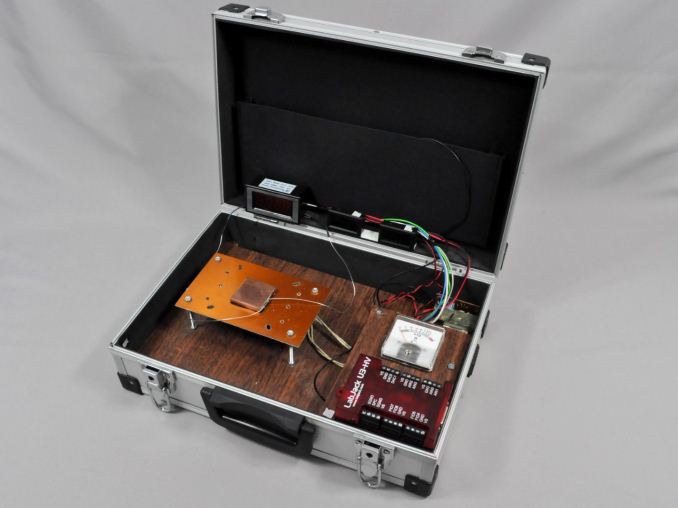
Appropriate thermal testing requires the creation of a proper testing station and the use of laboratory-grade equipment. Therefore, we created a thermal testing platform with a fully controllable thermal energy source that may be used to test any kind of cooler, regardless of its design and or compatibility. The thermal cartridge inside the core of our testing station can have its power adjusted between 60 W and 340 W, in 2 W increments (and it never throttles). Furthermore, monitoring and logging of the testing process via software minimizes the possibility of human errors during testing. A multifunction data acquisition module (DAQ) is responsible for the automatic or the manual control of the testing equipment, the acquisition of the ambient and the in-core temperatures via PT100 sensors, the logging of the test results and the mathematical extraction of performance figures.
Finally, as noise measurements are a bit tricky, their measurement is being performed manually. Fans can have significant variations in speed from their rated values, thus their actual speed during the thermal testing is being recorded via a laser tachometer. The fans (and pumps, when applicable) are being powered via an adjustable, fanless desktop DC power supply and noise measurements are being taken 1 meter away from the cooler, in a straight line ahead from its fan engine. At this point we should also note that the Decibel scale is logarithmic, which means that roughly every 3 dB(A) the sound pressure doubles. Therefore, the difference of sound pressure between 30 dB(A) and 60 dB(A) is not “twice as much” but nearly a thousand times greater. The table below should help you cross-reference our test results with real-life situations.
The noise floor of our recording equipment is 30.2-30.4 dB(A), which represents a medium-sized room without any active noise sources. All of our acoustic testing takes place during night hours, minimizing the possibility of external disruptions.
| <35dB(A) | Virtually inaudible |
| 35-38dB(A) | Very quiet (whisper-slight humming) |
| 38-40dB(A) | Quiet (relatively comfortable – humming) |
| 40-44dB(A) | Normal (humming noise, above comfortable for a large % of users) |
| 44-47dB(A)* | Loud* (strong aerodynamic noise) |
| 47-50dB(A) | Very loud (strong whining noise) |
| 50-54dB(A) | Extremely loud (painfully distracting for the vast majority of users) |
| >54dB(A) | Intolerable for home/office use, special applications only. |
*noise levels above this are not suggested for daily use
Our maximum speed testing is performed with both the fans and the pump of the kit powered via a 12V DC source. This input voltage should have the pump and fans matching the speed ratings of the manufacturer. According to the company’s specifications, the included 120 mm fans should have a rotational speed of 2500 RPM. Our tachometer indicated that the fans were rotating at an average speed of 2510 RPM, very close to the rated specifications and consistent to each other.
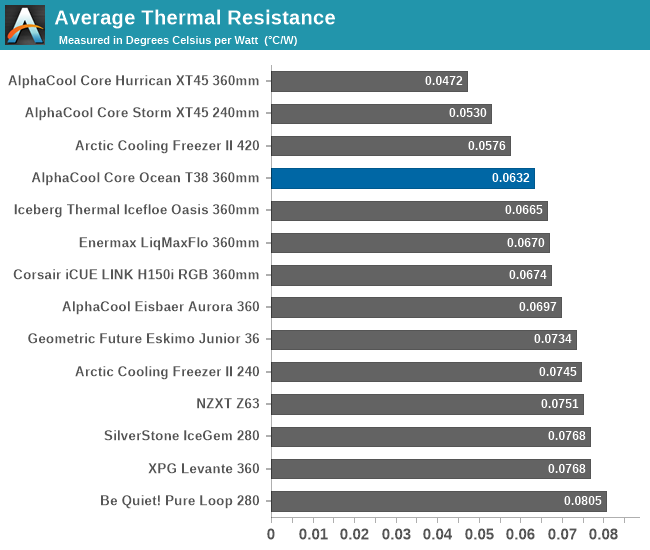

| Core Temperature, Constant Thermal Load (Max Fan Speed) |
The AlphaCool Core Ocean T38 360mm cooler demonstrates strong performance under various load conditions, achieving an average thermal resistance of 0.0632 °C/W at a maximum fan speed of 2510 RPM. Its thermal efficiency remains relatively stable across different loads. It lands at the top spots of our performance chats but we should not forget about the very high speed of the stock fans.
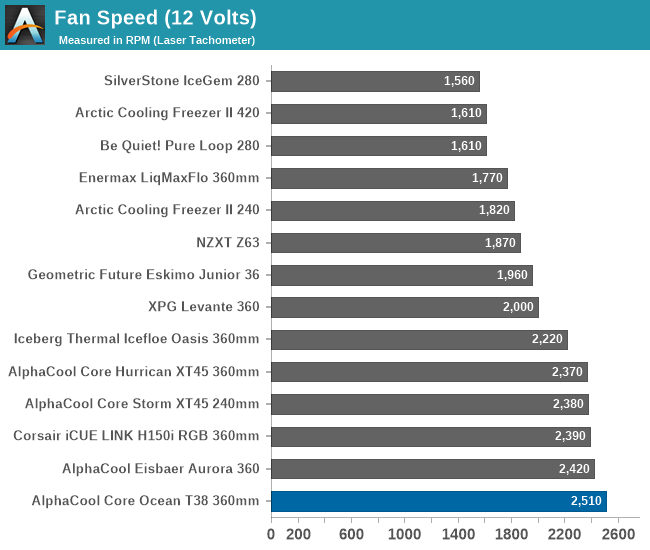
At a maximum fan speed, the AlphaCool Core Ocean T38 360mm cooler registers a noise level of 46.7 dB(A), which is considered high even for a cooler configuration that includes three 120mm fans. Despite its high thermal performance across various loads, the cooler’s high noise output is a significant factor, especially for users sensitive to sound levels in their computing environments. We should not forget that the fans feature full range PWM capability and users can adjust their speed at will, so the Core Ocean T38 simply has the capacity of reaching a high thermal performance at the expense of noise, it does not require it.

Using a PWM voltage regulator, we reduced the speed of the fans manually down to half their rated speed. At this setting, the 120 mm JE12025L12V fans of the Core Ocean T38 rotate at 1250 RPM.
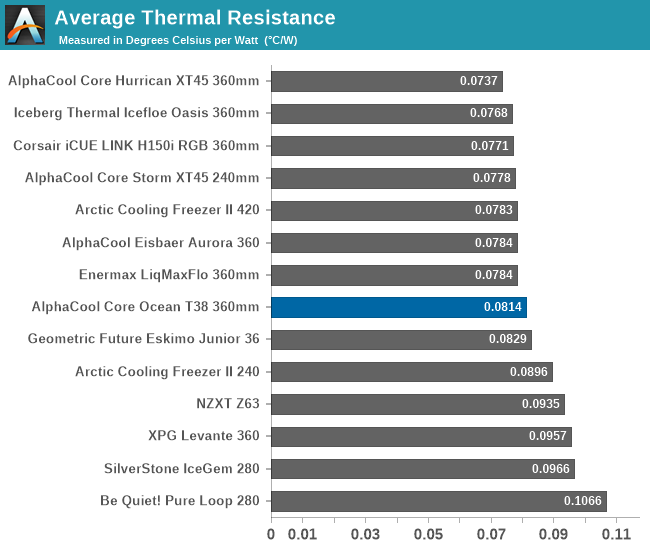

| Core Temperature, Constant Thermal Load (Low Fan Speed) |
The AlphaCool Core Ocean T38 360 mm cooler demonstrates good cooling efficiency, resulting to an average thermal resistance of 0.0814 °C/W. This performance figure positions it competitively, close to the efficiency levels of more complex and costly liquid cooling systems, yet we should not forget that this thermal performance has been achieved with the fans running at 1250 RPM, a figure much higher than that of most similar solutions.
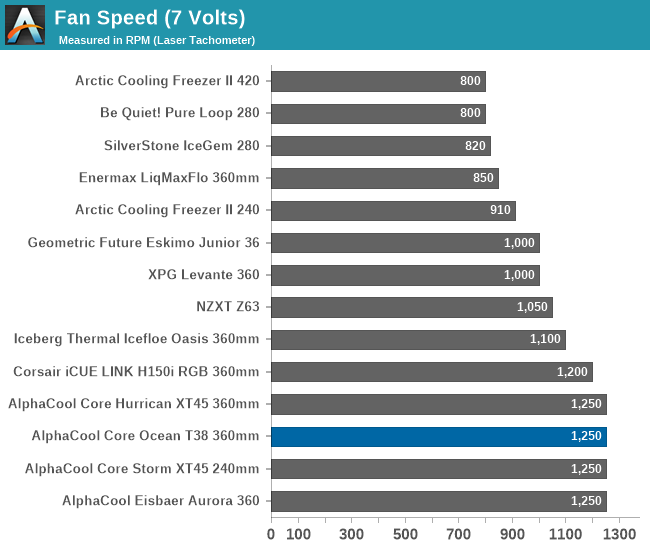
The acoustic performance of the AlphaCool Core Ocean T38 360mm cooler is rather mediocre even when its fans are operating at half speed. At this reduced speed of 1250 RPM, the noise level is 35.5 dB(A), which actually positions it as one of the louder options among cooling solutions that utilize three fans.
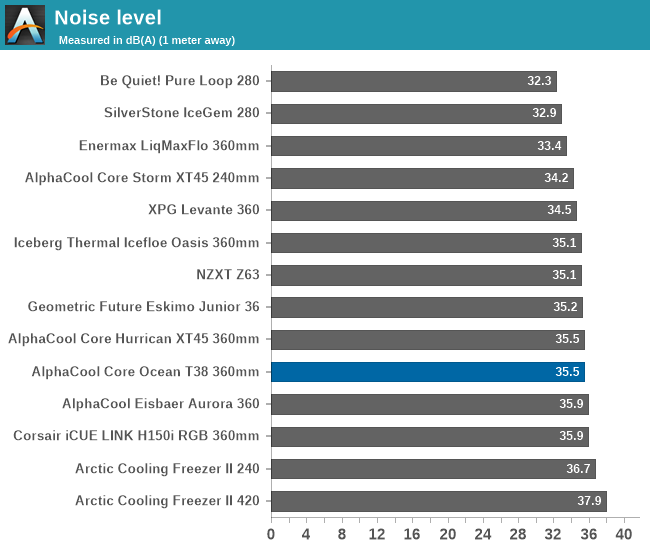
During our thermal resistance vs. sound pressure level test, we maintain a steady 100W thermal load and assess the overall performance of the coolers by taking multiple temperature and sound pressure level readings within the operating range of the stock cooling fans. The result is a graph that depicts the absolute thermal resistance of the cooler in comparison to the noise generated. For both the sound pressure level and absolute thermal resistance readings, lower figures are better.
The AlphaCool Core Ocean T38, with its full range 2500 RPM fans, offers a broad operational spectrum but does not quite match the thermal-to-noise performance of the Enermax LiqMaxFlo, a product sharing a similar design and radiator thickness. It performs almost similarly to advanced coolers with 27 mm thick radiators and even manages to surpass them, yet at very high fan speeds that push far to the right of the noise scale. This positions the AlphaCool Core Ocean T38 as a powerful, yet noisier alternative, especially under maximal operational conditions.
When it comes to AIO liquid coolers, the AlphaCool Core Ocean T38 is a noteworthy contender that’s difficult to ignore, even in the fiercely competitive AIO market. Especially for users seeking a balance between cost and performance, a 360 mm cooler with a $100 price tag is going to be an attractive offering, particularly with the T38’s size and capabilities. This makes the T38 a option for budget-conscious enthusiasts who are first and foremost looking for cooling efficiency.
Even with its budget price tag, the Core Ocean T38 does not cut corners with its structural build. It features a durable design, implementing high quality materials that promise longevity and resilience. The RGB lighting on the pump top adds a touch of modern aesthetics, catering to users who favor visual flair alongside functional performance, all without upping the price tag too much.
When it comes to performance, the Core Ocean T38 delivers robust thermal performance, which is mainly attributed to its thick 360mm radiator and very high-speed fans. While this allows the T38’s cooling efficiency to get to par with more expensive units, getting there comes with a caveat: the fans’ noise level can get considerably high, even by 360mm AIO cooler standards. The T38 is not shy about its capabilities, but it’s also not shy about its drawbacks – high performance comes at the cost of noise.
In conclusion, the AlphaCool Core Ocean T38 offers solid performance for its price, with its design allowing users to precisely dial in the balance between performance and acoustics they want, making it a pragmatic choice for users looking to optimize their system’s cooling without breaking the bank. However, users need to be aware that very high noise levels are required to reach the top thermal performance figures we saw on our charts. For those who want a reliable AIO cooler with a long adjustable range, the Core Ocean T38 represents a cost-effective solution to advanced cooling needs.
